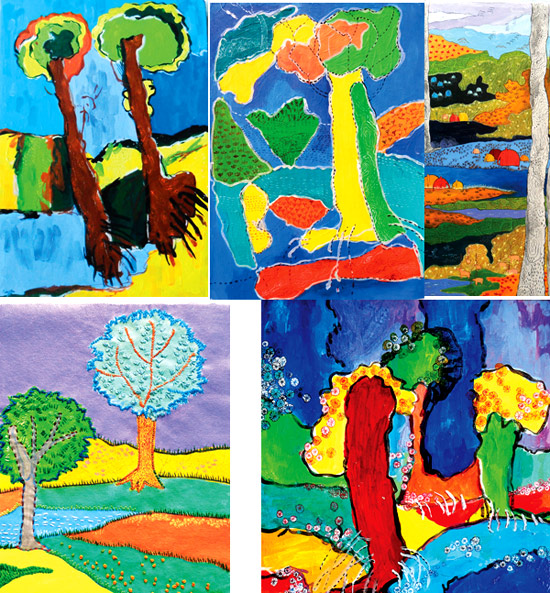|
‘Imagine’ art exhibition:
Special-needs children showcase their talents
By Anuradha Kodagoda
 Imagine being filled with emotion, yet unable to express how you
feel. That’s what many children with special needs face. Through art,
however, all children may freely express their feelings. Imagine being filled with emotion, yet unable to express how you
feel. That’s what many children with special needs face. Through art,
however, all children may freely express their feelings.
As an art teacher for special-needs children, Lakisha Fernando sees
the value of art in her classroom every day. “Children who have problems
with speech, language and motor skills struggle with verbalising what
they feel and need. This is frustrating for children, upsetting for
their parents and challenging for us as their educators.
 However, through art these children get an avenue to express their
feelings and emotions which may lead to an overall mental and physical
development of these children”, said Lakisha Fernando, the founder of
Savi Academy of Art. However, through art these children get an avenue to express their
feelings and emotions which may lead to an overall mental and physical
development of these children”, said Lakisha Fernando, the founder of
Savi Academy of Art.
Art therapist
Savi Academy of Art is an art school for children, where
special-needs children work in the same environment with others. As an
educationist and art therapist who has ample experience of working with
special-need children in many schools and organisations, Fernando set up
her own art school, Savi Academy of Art in 2013 mainly because of her
inner desire to devote herself for the betterment of special-need
children.
“I set up the Savi Academy of Art last year because it is a national
need to open avenues to sharpen the artistic skills of special-need
children as most of them are left out from their families and even from
schools after a certain age.
 Today it is a proven fact that art benefits cognitive and physical
development, strengthens problem-solving and critical-thinking skills,
develops a sense of goal-setting and nurtures social skills that are
critical inside and outside the classroom. Therefore, I strongly believe
that art is important for all children, while it’s crucial for those
with special needs,” Fernando said. Today it is a proven fact that art benefits cognitive and physical
development, strengthens problem-solving and critical-thinking skills,
develops a sense of goal-setting and nurtures social skills that are
critical inside and outside the classroom. Therefore, I strongly believe
that art is important for all children, while it’s crucial for those
with special needs,” Fernando said.
Miracles
She sets the example by proving the fact that art can do miracles in
human life by showcasing her students’ artistic talents through
‘Imagine’ art exhibition.
‘Imagine’ will exhibit a series of artwork named ‘Dream Landscape’
done by the special need children with Fernando.
“Dream landscape is one of my art series that I started in 2008. It
represented my thoughts and hopes in my childhood. From my younger days
I really enjoyed gardening and I was always very close to nature. I had
lots of fantasised ideas about colourful environment, beautiful trees,
flowers, streams and birds.
I used compositions and shapes in different ways from academic
landscape theory. I used a lot of intricate designs that could represent
my beautiful childhood dreams and fantasies. By observing the special
talents of special need children I decided to do landscape based on my
dream landscape series,” she said.
The children who have special needs can be a challenge to teach. They
often find it difficult or frustrating to succeed in “hands on”
activities. Using art as a means of teaching increases a child’s chances
for success and makes the experience pleasurable.
Speciality
“Most of children draw one thing or a few things very well. I chose a
group according to their speciality. When I build the composition I
always care about to highlight their special ability in art and guide
them to create their well-known figures and patterns. All figures,
patterns and colours represent their colourful thoughts and dreams. From
the beginning I chose their best shapes to buildup the composition.
Drawing and colouring they did under my supervision,” Fernando said.
“For the emotionally disturbed children I teach methods of
self-expression. They lack self-confidence, social skills and verbal
capabilities to express themselves. But, art represents one amazing
subject at school and home. Children with special needs can succeed in
art.
For special needs students, the planning that drives the artistic
process is more important than the finished work. The challenge is to
emphasise the process and eliminate feelings of failure when finished
works don’t live up to students’ expectations. Most importantly,
teaching children to appreciate art is a difficult task, she said.
With art, as in life, there are no failing grades. Regardless of
children’s developmental, physical, behavioural or emotional issues,
their artwork should be measured for their therapeutic and aesthetic
value. With art, there is no right or wrong answer. It’s simply created,
shared and appreciated.
Likewise, showcasing their work in a gallery gives children a sense
of pride and accomplishment, builds a positive attitude and enhances
feelings of self-worth, notably when they see other people admiring
their work. |

